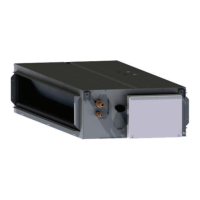3 Piping work and
refrigerant charge
93
3
SMGB0077 rev.0 - 01/2013
3.2 Copper pipes, sizes, connection and insulation
3.2.1 Copper pipes and sizes
C A U T I O N
• The copper pipe used in the refrigeration installations is different to the copper pipe used in installations
carrying domestic or heating water.
• The copper pipe for refrigeration installations is especially treated for outdoors and indoors. The interior
surface nish makes it easierfor the refrigerant to circulateand withstands the action ofthe lubricant oil
applied to outdoor equipment.
Prepare the copper pipes provided by the supplier.
Select the pipe with the appropriate diameter and thickness. Use the table below to select the most appropriate pipe:
Nominal diameter
Thickness mm Supply
mm Inches
Ø6.35 1/4 0.80 Roll
Ø9.52 3/8 0.80 Roll
Ø12.7 1/2 0.80 Roll
Ø15.88 5/8 1.00 Roll
Ø19.05 3/4 1.00 Pipe
Ø22.20 7/8 1.00 Pipe
Ø25.40 1 1.00 Pipe
Ø28.60 1-1/8 1.00 Pipe
Always use clean copper pipes with no signs of knocks or cracks. Make sure there is no dust or dampness on the inside.
Before you install the pipes, clean the inside with oxygen-free nitrogen gas to eliminate any remains of dust or other
substances.
C A U T I O N
• Do not use hand saws, circular saws, abrasive grinders or other tools that generate shavings.
• Strictly follow national or local regulations regarding occupational health and safety.
• Wear appropriate means of protection during cutting or brazing operations and installation (gloves, eye
protection, etc).
On completing the installation of the refrigerant pipes -B-, insulate
them appropriately using suitable insulating material -A- and seal
the open space between the holes made and the pipe, as shown
in the gure.
A
A
B

